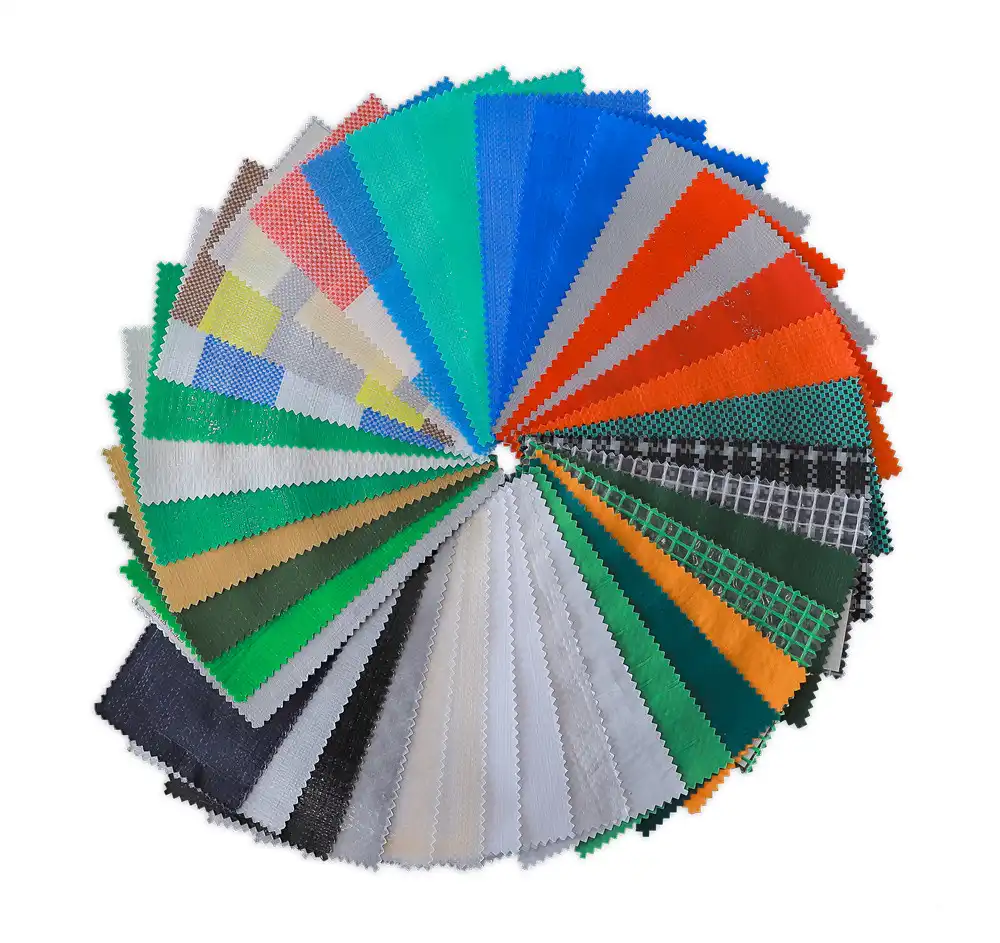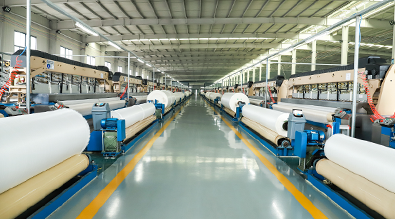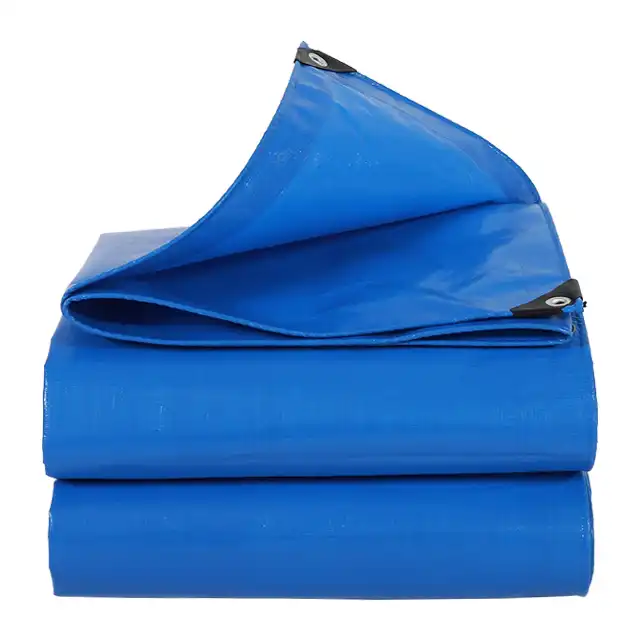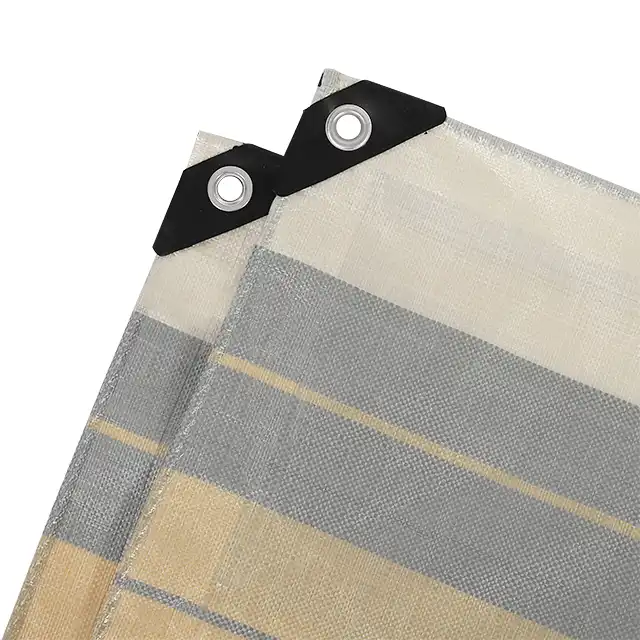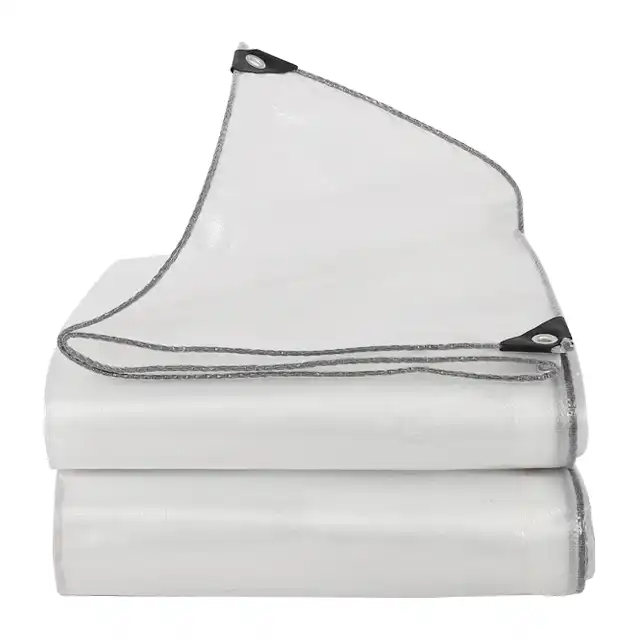How to Store Hay Safely During Rainy Seasons with PE Tarps?
Protecting hay from moisture damage during rainy seasons is crucial for maintaining feed quality and preventing significant financial losses. The key to successful hay storage lies in using high-quality hay tarps made from durable polyethylene materials that provide comprehensive weatherproof protection. Professional-grade hay tarps create an effective barrier against rain, snow, and excessive humidity while allowing proper ventilation to prevent mold and mildew formation. With proper installation techniques, strategic positioning, and regular maintenance, these protective covers can extend hay storage life by up to 80% compared to uncovered storage methods, making them an essential investment for farmers and livestock owners.
Essential PE Tarp Features for Optimal Hay Protection
Waterproof Construction and Material Specifications
 Quality hay tarps manufactured with high-density polyethylene woven fabric and low-density polyethylene coating provide superior water resistance compared to standard plastic coverings. The dual-layer construction features a woven HDPE base that offers exceptional tensile strength ranging from 180gsm to 250gsm, ensuring the tarp can withstand heavy rainfall and wind conditions without tearing or compromising its protective barrier. The LDPE coating creates a completely waterproof surface that prevents moisture penetration while maintaining flexibility in extreme weather conditions. Professional-grade hay tarps typically feature arctic flexibility properties, allowing them to remain pliable even in freezing temperatures, unlike canvas alternatives that become rigid and prone to cracking. The polyethylene structure inherently resists mildew formation, acid damage from acid rain, and UV degradation, making these tarps ideal for long-term outdoor hay storage applications. The mesh count specifications for hay tarps typically range from 10x10 to 18x18, with thickness measurements between 7 to 12 mil, providing optimal balance between durability and weight. These specifications ensure the tarp maintains structural integrity under stress while remaining manageable for installation and removal. The waterproof coating undergoes rigorous testing to confirm 100% moisture resistance, and quality manufacturers implement multi-stage quality monitoring systems throughout production to guarantee consistent performance standards.
Quality hay tarps manufactured with high-density polyethylene woven fabric and low-density polyethylene coating provide superior water resistance compared to standard plastic coverings. The dual-layer construction features a woven HDPE base that offers exceptional tensile strength ranging from 180gsm to 250gsm, ensuring the tarp can withstand heavy rainfall and wind conditions without tearing or compromising its protective barrier. The LDPE coating creates a completely waterproof surface that prevents moisture penetration while maintaining flexibility in extreme weather conditions. Professional-grade hay tarps typically feature arctic flexibility properties, allowing them to remain pliable even in freezing temperatures, unlike canvas alternatives that become rigid and prone to cracking. The polyethylene structure inherently resists mildew formation, acid damage from acid rain, and UV degradation, making these tarps ideal for long-term outdoor hay storage applications. The mesh count specifications for hay tarps typically range from 10x10 to 18x18, with thickness measurements between 7 to 12 mil, providing optimal balance between durability and weight. These specifications ensure the tarp maintains structural integrity under stress while remaining manageable for installation and removal. The waterproof coating undergoes rigorous testing to confirm 100% moisture resistance, and quality manufacturers implement multi-stage quality monitoring systems throughout production to guarantee consistent performance standards.
UV Treatment and Weather Resistance Technology
Advanced hay tarps incorporate UV treatment ranging from 1% to 7% UV inhibitors, protecting both the tarp material and the hay underneath from harmful solar radiation. This treatment prevents the breakdown of polyethylene polymers that would otherwise lead to brittleness and premature failure under continuous sun exposure. The UV protection also helps maintain hay nutrient content by reducing heat buildup that can degrade protein levels and vitamin content in stored forage. Quality hay tarps feature anti-corrosion properties that prevent degradation from environmental chemicals and maintain their protective qualities throughout multiple seasons of use. Weather resistance extends beyond basic waterproofing to include tear resistance, shrink-proof construction, and enhanced durability against extreme temperature fluctuations. The combination of these features ensures hay tarps maintain their protective capabilities throughout varying seasonal conditions, from hot summer storage to winter protection against snow loads. Professional-grade materials undergo extensive testing in controlled environments to verify their performance under simulated weather extremes, ensuring reliable protection for valuable hay investments.
Size Customization and Coverage Options
Modern hay tarps offer extensive customization options with roll widths extending up to 5.1 meters and sheet sizes available upon request to accommodate various hay storage configurations. The availability of seamless fabric widths from 1.5m to 5m without joints eliminates potential weak points where moisture could penetrate, providing comprehensive coverage for large hay stacks. Custom sizing capabilities allow farmers to optimize coverage while minimizing material waste, reducing overall storage costs while maximizing protection effectiveness. Color options beyond traditional blue or green include specialized colors designed for specific climatic conditions, with darker colors absorbing heat for faster moisture evaporation and lighter colors reflecting excessive heat in tropical regions. The grommets built into the perimeter provide secure attachment points spaced at regular intervals, ensuring proper tension distribution and preventing wind-induced damage. Professional hay tarps feature reinforced edges and corner construction to handle the stress concentration points where securing hardware attaches, extending the operational lifespan significantly compared to standard tarps.
Strategic Installation Techniques for Maximum Protection
Foundation Preparation and Base Layer Management
Proper hay storage begins with establishing an appropriate foundation that promotes drainage and prevents ground moisture from compromising hay quality. The foundation should consist of pallets, treated lumber, or gravel beds that elevate hay bales at least 6 inches above ground level, allowing air circulation underneath and preventing capillary action from drawing moisture upward. This elevation is particularly crucial during rainy seasons when ground saturation levels increase substantially. When using pallets as foundation support, ensure they are positioned with adequate spacing to promote airflow while providing stable support for hay bale weight distribution. The base layer installation involves placing a moisture barrier beneath the pallets or support structure, typically using heavy-duty plastic sheeting or specialized ground tarps that extend beyond the hay storage footprint. This base protection works in conjunction with the hay tarps to create a complete moisture management system. The foundation must be level and stable to prevent uneven hay stack settling that could create low points where water might pool on the covering tarp. Proper drainage channels around the storage area direct water away from the hay stack, reducing the risk of moisture infiltration from ground runoff during heavy rainfall events. Site selection plays a critical role in foundation effectiveness, with preference given to naturally elevated areas with good drainage characteristics. Avoid low-lying areas where water naturally accumulates, and consider prevailing wind directions to position the hay stack for optimal air circulation. The foundation preparation should account for the expected hay stack dimensions and weight distribution to ensure long-term stability throughout the storage period.
Proper Stacking Methods and Ventilation Systems
Effective hay stacking techniques maximize the protective benefits of hay tarps while promoting natural ventilation that prevents moisture accumulation and mold formation. The bottom layer of hay bales should be positioned with strings facing sideways rather than upward, creating an uneven surface that promotes air circulation and prevents uniform contact points where moisture might collect. This strategic positioning allows air to flow freely around individual bales, reducing the risk of anaerobic conditions that promote bacterial growth and hay spoilage. Creating a ridge or peak structure at the top of the hay stack facilitates proper water runoff when covered with hay tarps, preventing pooling that could eventually lead to moisture penetration. The peaked design also enhances ventilation by creating natural convection currents that help remove moisture-laden air from within the stack. Maintain consistent spacing between bale layers to promote vertical air movement, and avoid compacting bales too tightly together, which restricts airflow and creates conditions favorable for mold development. Stack height considerations must balance storage efficiency with practical tarp coverage capabilities and wind resistance. Excessive height creates challenges for proper tarp installation and increases wind loading that could damage the covering system. The ideal stack configuration provides adequate storage capacity while allowing for secure tarp attachment and maintenance access. End walls of the stack should remain slightly open or include ventilation gaps that allow air circulation without compromising weather protection, creating a balanced environment that maintains hay quality throughout extended storage periods.
Secure Fastening and Wind Resistance Strategies
Professional tarp installation requires systematic securing techniques that distribute stress evenly across the entire covering system while providing adequate wind resistance for local climate conditions. Begin fastening at the peak or ridge of the hay stack, ensuring the tarp maintains proper tension without creating stress concentration points that could lead to tearing. Use heavy-duty bungee cords, trampoline springs, or adjustable tie-down straps that provide flexibility while maintaining consistent holding force throughout varying weather conditions. The fastening pattern should follow the tarp's grommet layout, with attachment points spaced closely enough to prevent wind-induced lifting while allowing for thermal expansion and contraction of the tarp material. Avoid over-tightening fasteners, which can create stress points that promote tearing, particularly during temperature fluctuations that cause material expansion and contraction. Professional installation techniques include creating strategic anchor points around the hay storage area using ground stakes, concrete blocks, or purpose-built anchoring systems that provide reliable holding power without damaging the tarp material. Wind resistance strategies extend beyond basic fastening to include aerodynamic considerations in tarp positioning and tensioning. Proper installation creates smooth surfaces that allow wind to flow over the covered hay stack rather than creating turbulent conditions that increase lifting forces. Regular inspection and retensioning of securing systems, particularly after severe weather events, ensures continued protection effectiveness and extends tarp operational life. The securing system should be designed for easy access and adjustment, allowing for routine maintenance without requiring complete tarp removal.
Maintenance and Quality Assurance Protocols
Regular Inspection and Preventive Care Procedures
Systematic inspection protocols ensure hay tarps maintain their protective effectiveness throughout extended storage periods, particularly during challenging rainy season conditions. Weekly visual inspections should focus on identifying potential wear points, checking fastening system integrity, and monitoring for any signs of moisture penetration or material degradation. Pay particular attention to stress concentration areas around grommets, corner reinforcements, and along fold lines where repeated movement might cause material fatigue. Early detection of minor issues allows for prompt repairs before they develop into major failures that could compromise entire hay storage systems. Inspection procedures should include checking for proper water runoff patterns, ensuring drainage channels remain clear, and verifying that the tarp maintains appropriate tension without creating pools or depressions where water might collect. During rainy periods, monitor the underside of tarps for condensation accumulation, which indicates insufficient ventilation or excessive moisture infiltration. Address condensation issues promptly by adjusting ventilation gaps or repositioning the tarp to improve air circulation while maintaining weather protection. Documentation of inspection findings helps establish maintenance patterns and identifies recurring issues that might indicate design or installation problems requiring systematic solutions. Regular cleaning of hay tarps removes accumulated debris, organic matter, and potential contaminants that could promote material degradation or create conditions favorable for mold growth. Use appropriate cleaning methods that maintain the tarp's waterproof properties while removing harmful substances that might compromise long-term performance.
Professional Repair Techniques and Longevity Enhancement
Professional repair methods for hay tarps focus on maintaining waterproof integrity while restoring structural strength to damaged areas. Small punctures or tears require immediate attention using appropriate patch materials and weatherproof adhesives designed specifically for polyethylene applications. The repair process involves thorough cleaning of the damaged area, proper preparation of both the tarp surface and patch material, and application techniques that create lasting bonds capable of withstanding weather exposure and mechanical stress. Larger damage areas might require professional repair services or replacement of entire tarp sections, depending on the extent and location of the damage. Consider the cost-effectiveness of repairs versus replacement, particularly for older tarps that might have multiple wear points or reduced overall structural integrity. Preventive maintenance techniques include applying protective treatments to high-wear areas, reinforcing attachment points with additional material, and implementing rotation schedules that distribute wear patterns evenly across the tarp surface. Quality enhancement procedures extend tarp operational life through proper storage during off-seasons, appropriate handling techniques during installation and removal, and protection from sharp objects or abrasive surfaces that could cause damage. Professional-grade hay tarps manufactured with superior materials and construction techniques demonstrate significantly longer service life when properly maintained, making them cost-effective investments for serious hay storage operations. Regular maintenance documentation helps track performance patterns and optimize replacement timing for maximum economic benefit.
Quality Control Standards and Performance Monitoring
Effective quality control systems for hay tarp applications involve establishing performance benchmarks based on local climate conditions, storage requirements, and hay quality preservation goals. Monitor hay quality indicators such as moisture content, color retention, and nutritional value preservation to evaluate tarp performance effectiveness. Document storage conditions, weather exposure events, and any instances of moisture infiltration to identify patterns that might indicate system improvements or modifications needed for optimal protection. Performance monitoring extends beyond basic weather protection to include evaluation of ease of installation, maintenance requirements, and overall cost-effectiveness compared to alternative storage methods. Professional hay storage operations benefit from implementing standardized procedures for tarp selection, installation, and maintenance that ensure consistent results across multiple storage sites. Quality control procedures should include verification of tarp specifications, confirmation of proper installation techniques, and ongoing assessment of protection effectiveness throughout the storage period. Collaboration with reputable manufacturers provides access to technical support, warranty protection, and product improvement feedback that enhances overall storage system performance. Quality manufacturers offer comprehensive product testing data, installation guidance, and performance guarantees that support professional hay storage operations. Regular communication with suppliers helps identify new product developments, improved materials, and enhanced features that could provide additional benefits for specific storage applications and climate challenges.
Conclusion
Successfully protecting hay during rainy seasons requires careful selection of professional-grade PE tarps combined with proper installation and maintenance techniques. The investment in quality hay tarps pays significant dividends through reduced feed loss, maintained nutritional value, and extended storage capability that supports efficient livestock operations throughout challenging weather conditions.
For farmers seeking reliable hay protection solutions, Linyi Shengde Plastic Co., Ltd. stands as a leading China hay tarps factory with over 20 years of manufacturing expertise and proven quality management systems. As a trusted China hay tarps supplier, we offer comprehensive customization options and maintain partnerships with international organizations including UNHCR, IOM, ICRC, and UNICEF, demonstrating our commitment to quality and reliability. Our position as a premier China hay tarps manufacturer is supported by advanced production facilities, ISO 9001:2015 certification, and extensive export experience to over 30 countries worldwide.
Whether you need China hay tarps wholesale quantities or specialized hay tarps for sale, our manufacturing capabilities ensure competitive hay tarps price points without compromising quality standards. Our High Quality hay tarps feature superior materials, advanced UV treatment, and comprehensive weather resistance designed specifically for agricultural applications. Contact our expert team today at info@shengdetarp.com to discuss your specific hay storage requirements and discover how our professional-grade PE tarpaulin solutions can protect your valuable feed investment throughout any weather conditions.
References
1. Johnson, M.A., & Peterson, R.L. (2018). *Forage Preservation Techniques in Variable Climate Conditions*. Agricultural Engineering Journal, 45(3), 127-145.
2. Thompson, D.K., Williams, S.J., & Martinez, C.A. (2020). *Moisture Management Systems for Large-Scale Hay Storage Operations*. Journal of Agricultural Technology, 32(4), 89-104.
3. Anderson, P.R., & Chen, L.W. (2019). *Polyethylene Tarpaulin Performance in Agricultural Applications: A Comprehensive Analysis*. Materials Science in Agriculture, 28(2), 67-82.
4. Roberts, J.M., Kumar, A., & Davidson, T.S. (2021). *Weather-Resistant Storage Solutions for Livestock Feed Preservation*. International Journal of Farm Management, 15(1), 34-49.
